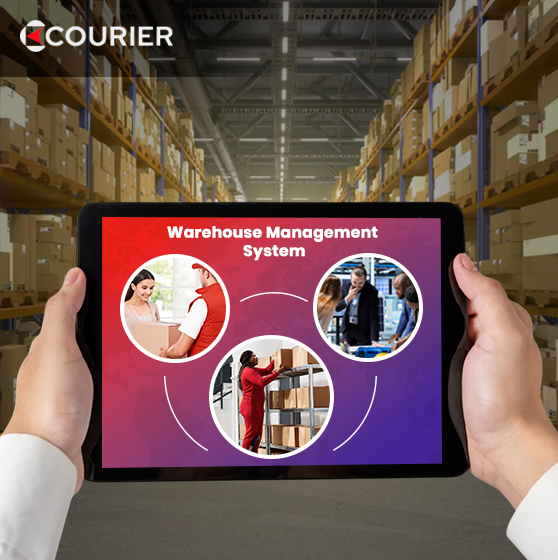
Imagine owning a warehouse where you occasionally stock your best-selling goods. What if these stored items someday lose their conditioning, while there is an urgent need for order fulfillment?
Without the proper idea of the item quantity, the chances of overstocking or understocking arise. As you try to track down the demand and sales, the manually written files prove to be useful.
However, these data can have multiple errors as staff fill them out. When you fail to meet the customer’s requirements, you lose patience, and the business goes haywire.
This is where having a warehouse management system can be valuable. It is a software that helps your company manage and control daily warehouse operations.
Through the system, you can track the entry of raw materials to the final delivery of products to clients. This application helps your business to handle warehouse functions efficiently.
A warehouse management system is essential to meet accurate, timely, and fast shipping demands while minimizing cost and maximizing quality.
If you are looking for a systematic way to manage your inventory, then WMS is what you need. In this blog, we will discuss the advantages of warehouse management systems, their definition, and types.
Table of Contents
What Does A Warehouse Management System Do?
Most businesses operate their warehouses smoothly on a smaller scale. They track their inventory manually, staff manage the stock locations, and on-floor coordination prioritizes tasks.
However, as order volumes multiply and SKUs become more diverse, traditional methods tend to slow down the process. You may start noticing errors, like task duplication, inventory mismatches, overstocking, and more.
Even the most minor errors can significantly impact the speed of order fulfillment. This is where a Warehouse Management System or WMS can be essential.
WMS software application controls and manages various operations within a distribution center or warehouse.
It enhances stock visibility across locations, allocates tasks based on the floor plan, and brings consistency in the logistics.
Through the system, you can control the picking, packaging, and dispatch requirements of your goods.
One of the top advantages of a warehouse management system is its capability to show real-time visibility into a company’s entire inventory from a single interface.
What are the Functions and Role of WMS?
WMS is a strategic partner that guides your business to make impactful choices. It helps you to make data-driven decisions through the complexities of the warehouse layout.
You can take care of cycle counting, precise inventory management, task interleaving, and wave planning. With the proper use of the software, you can optimize space utilization, enhance labor productivity, and offer a good customer experience.
The primary function of WMS is to automate the inventory management processes. However, it doesn’t restrict to simply fulfilling the orders. To understand the advantages of a warehouse management system, you first need to grasp its functions.
- Picking and Packing– By simplifying the picking and packing processes, WMS makes the entire process simpler. It guides your warehouse personnel through routes for quick order fulfillment.
- Inventory Management – One of the primary advantages of a WMS is its capability to handle inventory. This software provides real-time visibility to stock levels during transits.
- Resource Utilization – The warehouse management system optimizes resource allocation, including storage, labor, and equipment. They provide insights for efficient resource planning for overall operational efficiency.
- Receiving and Putaway– This software facilitates the smooth handling of goods upon arrival. It ensures an accurate inventory count and offers guidelines for proper pathways to maximize warehouse storage space.
- Warehouse Space Management– It integrates easily with automated systems like robots, conveyor belts, and automated storage and retrieval systems. This improves efficiency and reduces manual labor.
- Analytics– The software provides data-driven updates on warehouse metrics. These insights empower management to identify areas of improvement for better decision-making.
- Order Fulfillment – WMS streamlines the entire fulfillment process by ensuring accurate and timely picking, packing, and shipping of goods. It also maintains order accuracy and enables faster order processing.
- Compliance and Traceability – The Warehouse Management System ensures your business maintains compliance with regulatory requirements. With the software, you can track expiration dates, audit trails, and serial numbers. This ensures adherence to quality standards.
- Workflow Optimization– Reduced delays, minimized errors, and enhanced operational efficiency are some of the advantages of a WMS. By implementing it in your workflow, you notice improved order cycle times and better productivity within the warehouse.
Types of Warehouse Management Systems
Warehouse Management System varies in their deployment and capabilities.
Different systems cater to different warehouse sizes, industries, and complexities. Hence, when selecting a WMS, you need to consider your requirements to make a wise choice.
Don’t forget to check your scalability requirements, budget, and integration requirements before making a decision. By understanding the differences in structure, you can maximize the benefits of the warehousing system.
Listed below are the types of WMS systems-
1. Cloud-Based WMS
Cloud-based WMS is hosted on a remote server and retrieved through the internet. It provides flexibility, cost-effectiveness, and scalability.
The system removes the need for on-premises infrastructure and IT maintenance. This WMS provides data accessibility and is easy to integrate with other cloud-based solutions.
2. Standalone WMS
Standalone WMS focuses on optimizing daily warehouse operations. This independent application software enables efficient control and monitoring of the supply chain.
It keeps a track from the arrival of goods to their departure to the final destination. However, it requires additional integration with other business systems, requiring manual data entry.
3. Supply Chain Management WMS
Supply chain module refers to the additional features that integrate with the core warehouse management capabilities. These modules elevate the scope of WMS to make the end-to-end supply chain visible.
The functionality and depth of the WMS module may vary depending on the software provider. The supply chain software offers a different level of specialization than the WMS solutions.
4. Integrated WMS
ERP-integrated WMS is a part of the comprehensive suite of supply chain management software. These enterprise resource planning (ERP) systems provide end-to-end functionality.
They take care of the primary functions, including transportation management and demand planning. Crucial stuff like procurement and financial requirements is also taken care of. Integrated WMS offers seamless integration and data flow between different modules. This provides a holistic view of the entire supply chain.
Standard Features of Warehouse Management Systems
Modern warehouse management systems create value through an interconnected ecosystem. They work in harmony to optimize every aspect of the operations.
It serves as a staging ground for a customized and robust set of solutions tailored to your workflows. It also ties together a team beyond your warehouse walls, including engineering, IT, sales, and more, to maintain transparency.
Here are some standard features of the warehouse management systems-
- Returns Management – A WMS offers the features to manage reverse logistics and return handling. It also streamlines the restocking, inspecting, and handling of goods for optimal customer satisfaction.
- Automation- A modern warehouse system provides tools, like barcode scanners, automated guided vehicles, and RFID technology. They help you to streamline the order fulfillment process. Automating processes will help you increase productivity, reduce manual errors, and increase the turnaround time.
- Cloud-Based Capabilities- The cloud-based solutions offer benefits like easy accessibility, deployment, and automatic updates. These WMS eliminate the need for on-premises infrastructure. Scalability and data security are also advantages of the warehouse management system.
- Labor Management- It has labor management features to elevate the workflow. By implementing the software in your organization, you can easily track your workforce. You can get tools for labor planning, incentive management, and performance tracking, enabling you to monitor and motivate your laborers effectively.
- Integration with the Supply Chain- Workflow management systems integrate seamlessly with the supply chain management. By integrating with inventory planning and transportation management, it can create a seamless flow of information.
- Analytics and Reporting- WMS offers complete analytics and reporting capabilities. This allows you to monitor key performance indicators and gain information about the warehouse. One of the top benefits of WMS in a warehouse is the capability to track metrics like inventory turnover, order fulfillment rates, and make data-driven decisions.
What are the Benefits of a Warehouse Management System?
Every business needs a good storage space to safeguard its products and distribute them efficiently. They serve as a hub for receiving and storing goods and fulfilling orders. These reasons demonstrate the importance of a warehouse in meeting customer demand.
Moreover, a strong digital warehouse system is crucial for a business with traditional inventory. This system helps control the flow of labor and products within the fulfillment center.
While basic WMS can manage the pick, pack, and deliver requirements of your business, it isn’t capable of handling the large SKUs.
An updated warehouse management system enhances workflow, reduces costs, minimizes errors, and ensures faster delivery. It provides a roadmap to the organization, allowing your business to plan for contingencies to safeguard its supply chain.
The capability to improve a firm’s operational efficiency is why WMS is essential in the ever-changing market.
Here are some of the top warehouse management system benefits-
1. Good Inventory Management
With the software, you gain better visibility and control over your inventory. It enables you to monitor stock levels and product movements, as well as manage stock locations. This visibility aids you in preventing overstocking or understocking situations.
2. Cost Savings
WMS optimizes space utilization and reduces operating expenses. When you start arranging your warehouse layout, your storage capacity automatically increases. You start reducing overhead costs and wasted space. Improved inventory management also minimizes the carrying expenses.
3. Enhanced Security
Implementing WMS elevates warehouse security by tracking inventory movement and implementing access control. Robust security is one of the top benefits of using WMS, as it enables you to prevent unauthorized access and theft. You can easily identify discrepancies and take action by maintaining the correct records.
4. Better Order Fulfillment
With this system, you can streamline the order fulfillment process. This facilitates timely and accurate deliveries. The software enables hassle-free picking, packing, and shipping of items. You can minimize errors and enhance customer satisfaction.
5. Accurate Demand Planning
You can gather precise data on inventory levels, customer trends, and order history with this software. With barcoding, sensors, RFID tagging, or other location tracking methods, a WMS system offers real-time insight. This data is essential for understanding demand forecasting and planning. You can make sure that there are the correct stock levels to meet customer requirements.
6. Customer Satisfaction
When you start delivering accurate orders on time, your customer satisfaction level increases. A warehouse management system reduces delivery time by offering real-time visibility into order status.
Both the customer and seller can track the items for maximum clarity. Happy clients are more likely to repeat orders and endorse your company to others.
7. Enhanced Operational Efficiency
WMS systems automate your entire warehouse processes from inbound raw materials to deliveries. They focus on efficiency, operations, and the ability to handle large volumes.
This software tracks down errors in picking and shipping goods. Moreover, it eliminates duplicate work. It also shares data with ERP management and logistics, giving you a holistic outlook.
What are the Disadvantages of a WMS?
It’s essential to weigh up both the advantages and disadvantages of WMS before deciding whether new software is right for your business. Despite its multiple benefits, WMS also has issues that can hinder the initial process.
These factors need checking before making a decision. The challenges occur during the initial implementation stages and the ongoing operation of the system.
The following are some of the WMS disadvantages you may wish to consider:
- High Initial Investment – Installing new software in your business processes is a significant decision. The process requires a significant initial investment. You have to purchase the software and train the employees to use it properly. This is a time-consuming process that can temporarily reduce the productivity of the warehouse.
- Need for Staff Training– Learning new software is essential for running an efficient warehouse. However, teaching the existing employees its use may take some time. WMS can be complex for them if they lack a background in technology. This can lead to errors and incorrect data interpretation. Skipping this crucial step can increase the risk of data alteration.
- Single Point of Failure– Integrating the processes of multiple warehouses into a single unit can fall under both the WMS advantages and disadvantages. A single error could impact other stages, leading to issues in the warehouse function. Any downtime in the system can lead to significant losses. To reduce this risk, it is essential to have a data backup, regular maintenance, and a contingency plan.
- Risk of Incorrect Process Configuration- Proper configuration of processes is crucial to ensure that the WMS is running efficiently. Such errors can lead to unproductive warehouse operations and misdirected storage locations. It can also cause inventory tracking failures and delays in order fulfillment. Therefore, it is essential to choose a good developer and configure the system to match your business needs.
- Data Maintenance – Although the data sources and systems are linked to your Warehouse Management Software, the tasks are not entirely automated. You will need to ensure that the data transfers correctly. It is essential to check that the integrations remain connected. This entire process may require at least a month. This can again slow down the initial operation.
Courier Platforms- The Efficient Tool for Warehouse Management
In today’s evolving world, supplying quality products to the clients is the ultimate target of business owners. To fulfil this goal, they need to own a technologically advanced storage space, which is why warehousing is essential.
To run operations smoothly, you need to invest in strong software like WMS. Cost-saving efficiency, competitive edge in the market, and smooth operations are some of the top advantages of a warehouse management system.
Through its proper use, you make proficient savings and gain high customer satisfaction. At Courier Platforms, we simplify your warehouse management needs.
Our warehouse storage solutions offer cost-effective and secure storage spaces to help you fulfill your client orders. We have climate-controlled and 24/7 monitored warehouses that ensure your goods remain fresh and protected for a long time.
Rest assured, we will also take care of your first-mile and last-mile delivery needs for smooth logistics.
Take the first step towards a streamlined work operation with Courier Platforms today!
Recent Posts





 25th September , 2025
25th September , 2025 





